Table of contents
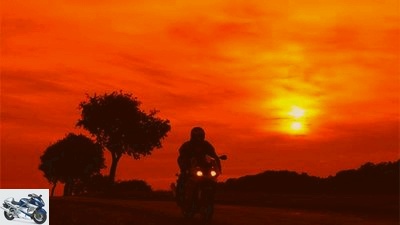
Breakable
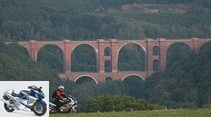
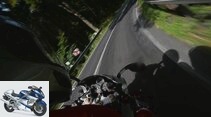
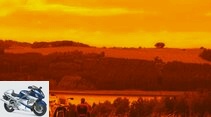
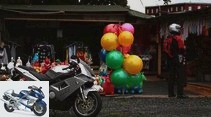
20th pictures
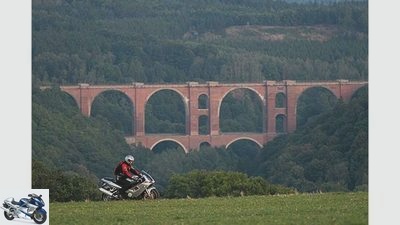
Breakable
1/20
Drive from Steinsdorf to Trieb: The Elstertal bridge emerges from the green waters, like the Goltzschaltal bridge built entirely from bricks.
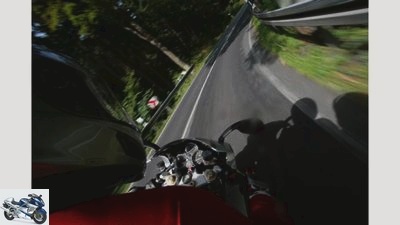
Breakable
2/20
Insider tip Vogtland: You can never get away from the curves here. That’s what Uwe, the local, says. He doesn’t want to go anywhere else.
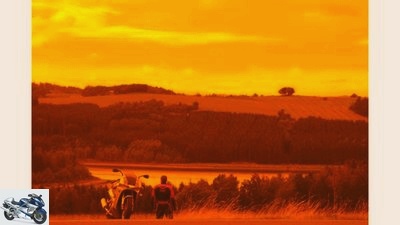
Breakable
3/20
The stuff the beers are made of: The Sternquell brewery gets its clear brewing water from the Droda dam.
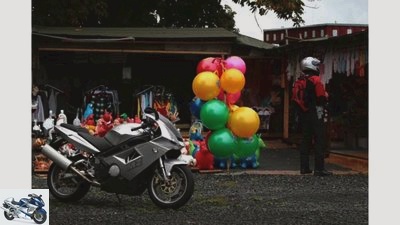
Breakable
4/20
Not in the mood for it: Uwe has little interest in the colorful, cheap Asian markets behind the Czech border.
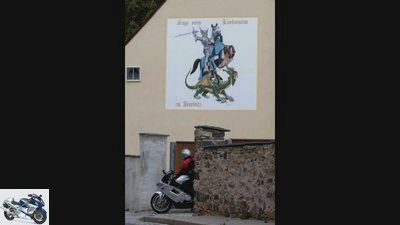
Breakable
5/20
According to legend, the farmers of the village of Kurbitz were threatened by a voracious dragon for years. A knight wanted to help, but the dragon ate his horse. In doing so, the dragon exposed itself, the knight struck. While still in agony, the dragon slew the knight with his tail.

Breakable
6/20
Eastern icons then and now: MZ 1000 S with Trabant 601, which was built from 1964 to 1990. After all, almost three million times.

Breakable
7/20
Memorial in Modlareuth: In the formerly divided village, a Russian tank, the border fence and a watchtower give you goose bumps.
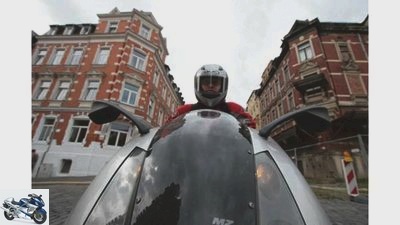
Breakable
8/20
Driving valuable: In addition to Art Nouveau facades and an MZ 1000 S clique, Plauen has a hell of a lot of curves for a city.

Breakable
9/20
The route: The exact route you take in the Vogtland is irrelevant, because most of them immerse yourself deeply in the essence of the Vogtland, offer a high level of experience and driving challenges in the form of strongly changing asphalt quality, many curves, numerous steep mountain and valley sections as well as surprising prospects.
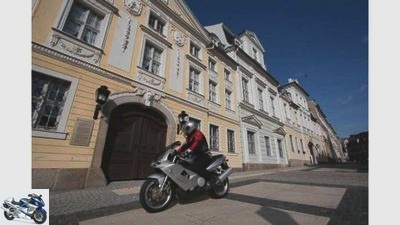
Breakable
10/20
Wilhelminian style and Art Nouveau houses shape the cityscape of Plauen, where it is easy to live thanks to high living standards and low rents. Even motorcycling is fun here, because the difference in altitude in the city is over 200 meters.
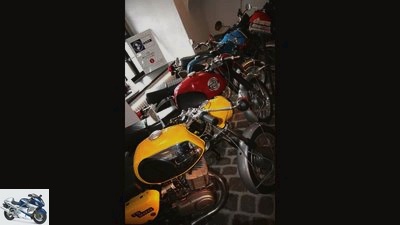
Breakable
11/20
Motorcycle get-togethers: At the Schleizer Dreieck and in Eibenstock at the dam.
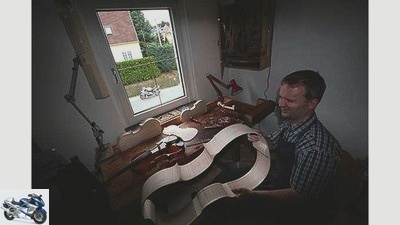
Breakable
12/20
Motorcycling master violin maker: Sven Gerbeth pays attention to the highest precision when making the instruments and loves BMW bikes.
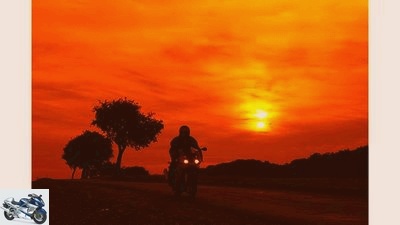
Breakable
13/20
With the MZ 1000 eastwards through the twilight: MOTORRAD editor Markus Biebricher was out and about in the Saxon Vogtland.
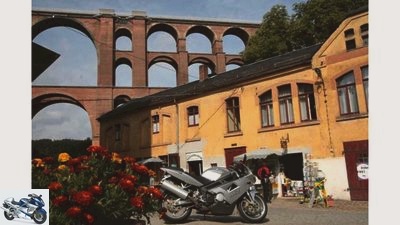
Breakable
14/20
World record: 26 million bricks were used for the Goltzschtalbrucke from 1846, 1736 people found a job.
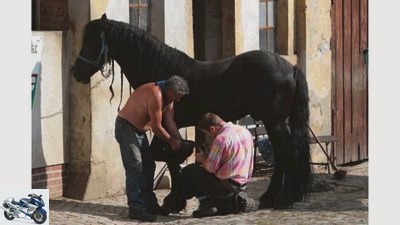
Breakable
15/20
Drive to the world-famous Goltzschtalbrucke: In its shadow, many companies thrive, and the farrier also has orders.

Breakable
16/20
Restored and ready to drive: Uwe’s father drove to work on this MZ ES 150 for 25 years. Uwe restored it after 150,000 kilometers.
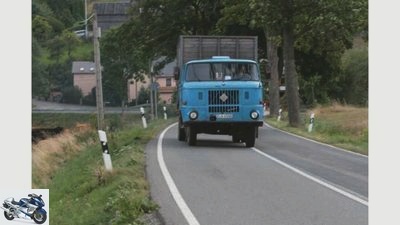
Breakable
17/20
IFA W 50 was the name of the most important truck in the GDR. IFA stood for “Industrie-Verband Fahrzeugbau”, the W 50 has a 6.5-liter four-cylinder diesel with 125 hp, VEB Automobilwerke Ludwigsfelde built it from 1965 to 1990. It rattles and rattles to this day, has over forty Countries exported.
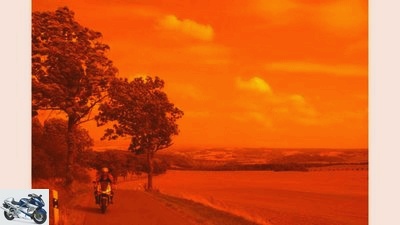
Breakable
18/20
Drive and enjoy: small streets as a stage for great driving deeds. Here between Kemnitz and Krebes.
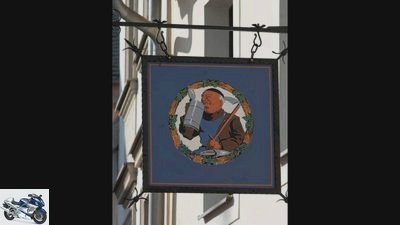
Breakable
19/20
The Vogtland cuisine is nutritious, hearty and powerful, everything revolves around the potato. But “Bambes” (buttermilk potato pancakes) and other specialties are dying out. Under the seal “This is how Vogtland tastes”, restaurateurs want to revive the local cuisine. Try out!

Breakable
20/20
Drive to the center of Plauen: the old town hall with art clock and sundial has been rebuilt again and again since 1382.
to travel
Saxon Vogtland
Saxon Vogtland
Always further east
At the invitation of an old friend from Plauen, MOTORRAD editor Markus Biebricher headed east. Adventurous GDR stories, green hills, winding slopes and upright people awaited him in Vogtland – a wild, colorful mixture.
Markus Biebricher
09/24/2009
For Uwe, a surveyor in Plauen in Saxony, his motorcycle is a universal mobile. It transports people, beer crates, small furniture and spare parts. At the moment it is sports equipment. The guy drives like there’s no tomorrow. He flies through the curves at high speed, you can feel his intimate connection to this area, the intimate knowledge of the streets. Like a blood cell through the vascular system, Uwe hunts over the branched network of asphalt veins that runs through the hilltop landscape of the Vogtland. He grew up with these routes, training them until he could part them with his footpegs.
Buy complete article
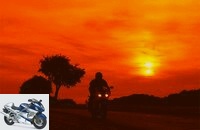
Saxon Vogtland
Always further east
12 pages) as PDF
€ 2.00
Buy now
When the girls in the west were already distributing their favor based on displacement and disdaining the pillion seat of the 550 as soon as a guy waved on a 750, Uwe and his buddies in Vogtland were still on Simson mopeds along silent forest paths. At the time, gray prefabricated buildings were more popular than romantic old apartments because the latter had no central heating and often only an outhouse in the stairwell.
At some point Uwe’s father rolled the silver one MZ ETZ 150 in the “De Luxe”-Execution in the yard.
At the latest then the twelve-year-old became terminally infected with the virus. He sat down on the single-cylinder engine, saw the disc brakes, the bright control lights in the cockpit, his first contact with a 12-volt electrical system. Shivers ran down his back and he thought: “What a motorcycle!” The father and the predecessor ES 150 had rattled from Weischlitz to Plauen to the Plamag printing machine factory every day. 25 years and 150,000 kilometers long, summer and winter. Uwe knew he wanted a real motorcycle as soon as he grew up.
The chances were not bad, because there was not the same shortage of motorcycles in the GDR as there was of cars. You waited 14 years for a car, so it was good to order one right after the birth. When the notification finally came, one was led into a hall in Zwickau, where, depending on the location, one or a maximum of two colors were available. You looked for yourself “his” Trabi and was the happiest person on earth. This is what happened to Uwe’s parents in 1988. Many who were not lucky had to look to the used vehicle market, where the cars were more expensive than when they were new. So off to the motorcycle dealer IFA-Mobile, which was mostly well equipped with MZ and Simson.
Before Uwe’s first “right” Motorcycle ceased to exist in the GDR. In autumn 1989 the state power was not defeated first in Leipzig, but in Plauen, Uwe’s place of residence, the capital of the Saxon Vogtland, starting point of our tour. Outside of Plauen, almost no one knows about this historic act. It was Saturday, October 7th, 1989, two days before the first big Monday demonstration in Leipzig. The SED celebrated the 40th anniversary of the GDR when Siegmar Wolf, a Plauen master craftsman, stood on a large sculpture in the city center and unrolled a banner: “Freedom of travel, free elections and, above all, peace” stood on it. Wolf was probably the first demonstrator in autumn 1989 who dared to hold up a banner. An extremely risky act in Plauen, where no Western correspondents held their protective hand over unknown critics of the regime.
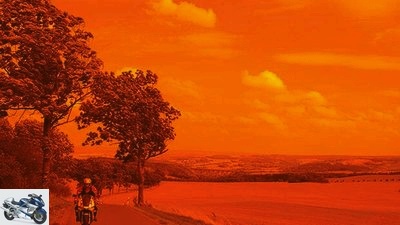
Breakable
Drive and enjoy: small streets as a stage for great driving deeds. Here between Kemnitz and Krebes.
With a few hundred “Disruptors” the Stasi had reckoned, but not with 15,000 people in a city of 74,000 inhabitants at the time. Wolf stood in front of the crowd with his banner, another suddenly pulled out a GDR flag from which he had cut a hammer, compass and wreath of ears. The crowd chanted: “Stasi out” and “Gorbi, Gorbi”.
The security forces fought back with two fire-fighting trains that they had converted into water cannons. Paving stones and beer bottles flew until one of the two water cannons failed and the other was withdrawn.
The people almost stormed the town hall in which the SED mayor had holed up. On the same day, the responsible police chief was dismissed, the Plauener had made the beginning to change their world. Unfortunately in camera, because there were no television pictures. The following Saturday the people of Plauen demonstrated again, this time Uwe was there with his father, candles were standing on the steps of the Luther Church opposite the town hall. But a Saturday demo in a city that hardly anyone knows can hardly keep up with a Monday demo of which western television shows pictures.
The people of Plauen are tired of not being noticed, they want to fight for their place in the history book. While feeling the temperature of his tires, Uwe explains why the need for recognition among people is so strong: Plauen was once a city of civic pride. In 1912 130,000 people lived here, and the city was a center for mechanical engineering and the textile industry. Uwe knows from his grandfather that people from the Franconian court came to Plauen, “because there was just more going on”.
The city’s industrial operations were fatal in 1945. More bombs fell here per square kilometer than in Dresden. Plauen does not even seem to be granted a top position in the public perception in this ranking. In a united Germany, Plauen does not stand for anything special, at most for “Plauen lace”. It is a pretty town with impressive Wilhelminian-style buildings that would have fallen into disrepair if it hadn’t been for the turning point. Today they shine in their old splendor, the infrastructure, cultural offerings and the bar scene are impressive. Cruising through Plauen on a motorcycle is much more fun than in other cities, because it is so often up and down and so jagged around countless corners.
The Plauen area also seems to consist only of curves, mountains and small streets. It tingles under the helmet, it feels kind of like the first time out at the age of 18, and suddenly it’s there: huge driving pleasure. We poach to Weischlitz and sit down with Uwe’s father in the garden of his parents’ house, which was still built in GDR times and had to make do with sacks for the first few months after completion due to the lack of doors. Now everything is tip top, we drink Sternquell-Pils, a Plauen beer that is brewed with the water of the Droda dam and that was recently named the best beer in Saxony by the Federal Ministry of Food, Agriculture and Consumer Protection.
We toast to that. And on the motorcycle that is parked in the courtyard entrance. A beautifully restored MZ ES 150. The same one with which Uwe’s father drove to work for 25 years. “You could see the 15000 kilometers on the part”, tells Uwe. When his parents traveled to Canada for their silver wedding anniversary, Uwe bought a second ES-150 wreck for a case of beer to turn two into a motorcycle. He carried out the rebuilding in a friend’s garage in Oelsnitz. When he returns home, his father, completely exhausted, unlocks the garage door – and what is in front of him? His MZ, sparkling as new, ready to drive and approved.
Uwe is just as proud of that as he is of his 2005 MZ 1000 S. I listen to its sound the next morning as it babbles in push mode and yells when he pulls the cable after the curve. Nice sound, but there is sound in a more lovely form everywhere here, because we are now through the “Music angle” of the Vogtland. From Bad Elster to Landwust, from Markneukirchen to Klingenthal. Uwe threshes the MZ up the Aschberg driveway and shows a view from almost 1000 meters that looks almost alpine. At our feet is the place that enjoys the best international reputation among orchestral musicians, together with Markneukirchen or Schoneck. Up until the Second World War, an unbelievable 80 percent of the orchestral instruments used worldwide came from Vogtland.
Sven Gerbeth, master violin maker and friend of Uwe, who learned his trade from an ancient master, absolutely wants to test drive the BMW. Unfinished violins, violas and cellos lie and hang in his workshop, fine wood shavings curl on the floor, glue and varnish perfume the room. Even today the business with master violins is going so well that Sven doesn’t have to worry about his future and can easily buy a new motorcycle every now and then. In contrast to Uwe, Sven likes Bavarian machines. He doesn’t have MZ, but BMW in his blood, which Uwe considers an incurable disease.
..Uwe couldn’t leave MZ,..

Breakable
The stuff the beers are made of: The Sternquell brewery gets its clear brewing water from the Droda dam.
Uwe could not leave MZ, follows the company’s fate like other people, soccer results or stock prices and is a changing type compass of MZ motorcycles from 1950 to today. His first real motorcycle was a Scorpion, and the second was the 1000 S that he drives around my ears here every day. He is critical of all recent attempts to bring the long-established company that once employed such ingenious engine designers as Walter Kaden back to the front. He doesn’t trust the youngest investors Waldmann and Wimmer either: “Why do all new managing directors always have to race first instead of whipping up the company??” But now Sven comes back from the test drive with shining eyes and ends our conversation with an offer to buy the BMW.
The Czech Republic begins behind Klingenthal. Uwe neither likes the brightly colored Asian markets that sprout just across the border, nor does he like the Germans who travel to the neighboring country with 30,000 euro cars because “the food is so nice and cheap”. Not to mention the guys who want to push an inexpensive number on the other hand. Before, says Uwe, “the Czech Republic was popular with the Vogtlanders, there were trainers and better clothes here”. Also heating thermostats, tiles and other building materials that were only available in the GDR with highly explosive connections.
A few Vogtland villages still spread the sadness of the old GDR today. Gray zone plaster is crumbling from thin-walled apartment boxes, worn cobblestone pavement pulls a holey lane through the town. Modern building materials still seem to be in short supply, you don’t want to know what’s going on behind the flowered curtains.
Pausa isn’t like that, Pausa isn’t a village either. And if the Vogtland capital Plauen does not manage to be the center of the world, the Pausaner at least have access to the earth’s axis. It appears symbolically in the basement of the lush town hall. Here we can observe their rotation, by means of an automatic itself “Earth axis lubricant” oil and thus help determine the course of the world. The lubrication process is controlled by the “Erdachsendeckel hinge grease nipple commission to Pausa e.V.” supervised.
Surveillance was the determining element in the life of Mrs. Wohlfahrt in the GDR, who ran a small snack bar and grocery store in Gefell” leads. That was the stuff that was always illegally under the counter. Frau Wohlfahrt embraces Uwe, who works in Tanna and always rushes to Gefell to eat. Uwe already knows her story, the others are allowed to listen. During the GDR era, she lived within the five-kilometer-wide border strip that was cordoned off from the rest of the country in order to make it more difficult for those who were tired of the republic to escape. She was only allowed to pass the checkpoint with a pass when she wanted to go home and when she wanted to go to work that was outside the control zone.
It was even worse for the residents of Modlareuth, whose town was cut in half by the control strip. Today there is a museum here, a gutted Mil Mi 17 helicopter is parked not far from a T 34 tank and is a reminder of the power of the Russian brother state. As if he wanted to escape the shadows of the past, Uwe hammers the MZ back through the hills via Misslareuth, Grobau, Kemnitz, Krebes, Schwand, Weischlitz to Plauen. A roller coaster ride through a landscape that would be every model train owner’s dream. The motorcycles rebound on the hilltops as if they were about to take off. After all these years, Uwe’s joy in the streets has not diminished a bit.
In Plauen, the city that initiated the fall of the GDR, we sit in the evening “mud”, the oldest restaurant in Plauen, and eat “Bambes”, a variant of potato pancakes. With sweeping gestures, Uwe explains that you can practice tight and wide arcs particularly well on the new surface in Goltzschtal when the blonde waitress draws attention to herself with an even more convincing combination of curves. Whereupon the conversation deviates a little from the ideal line. I can see from my guide that he is wondering whether the MZ 1000 S could perhaps also serve as a tow truck.
Info

BILLION
The Vogtland attracts motorcyclists.
The Vogtland attracts motorcyclists. Anyone who leaves the A 72 between Hof and Zwickau is right in the middle and can immediately collect curves. To prepare: www.vogtlandtourist.de, www.echt-vogtland.de. The trip will be unforgettable!
General: The name Vogtland goes back to Emperor Barbarossa, who appointed so-called bailiffs in the 12th century, who secured and controlled his rulership. Located in the heart of Europe and directly on important trade routes, this region of Saxony, which has remained relatively natural to this day, was able to flourish economically for the first time in the Middle Ages. The forested hills of the Vogtland lie in the triangle of Bavaria, Bohemia and Saxony and form the westernmost part of the Erzgebirge-Vogtland Nature Park. As a result of a tectonic fault, harmless so-called swarm tremors still occur here today. The Vogtland owes its landscape form to such geological activities as well as some mineral springs, which have given the state spas Bad Elster and Bad Brambach lively spa operations since the beginning of the last century. The rest of the Vogtland also took off again at this time and, thanks to the flourishing textile industry (Plauener Spitze), respected mechanical engineering companies and the production of coveted musical instruments, achieved economic prosperity and a solid infrastructure. Impressive bridges bear witness to this era, the most famous of which is the Goltzschtal bridge.
Sightseeing features: As the largest city in the Vogtland region, Plauen enchants with lovingly restored Art Nouveau facades, while Syrau takes the visitor into the underground stalactite world of his dragon cave. Music lovers will be delighted with the Instrument Museum in Markneukirchen. Klingenthal is not just another center for master instrument makers from the Vogtland region, it is also home to Europe’s most modern large hill with a unique elevator construction. The space exhibition in Morgenrothe presents the technical and historical highlights of international space travel and gives an impression of the benefits of space research. The next attraction in the form of the Goltzschtalbrucke near Netzschkau towers high in the northern Vogtland.
The extremely imposing structure is the largest brick bridge in the world with four floors, 98 vaults, 78 meters high and 574 meters long. A detour to Schleiz in Thuringia is also worthwhile: Here you have the opportunity to drive Germany’s oldest natural race track, the famous Schleizer Dreieck. The greatest highlight of the Vogtland, however, is its untouched landscape, through which a network of lonely roads and paths stretches. A real paradise for motorcyclists with countless hairpin bends, climbs and descents. Sporty natures get their money’s worth here as well as hiking connoisseurs, there are legally passable dirt roads for enduro riders. Palaces and castles look down on all these splendors, such as the castles Mylau, Schonfels and Voigtsberg. It’s also worth taking a look here.
Motorcycle meetings: At the Schleizer Dreieck and in Eibenstock at the dam.
The distance: The exact route you take in Vogtland is irrelevant, because most of them immerse themselves deeply in the essence of the Vogtland, offer a high level of experience and driving challenges in the form of strongly changing asphalt quality, many bends, numerous steep mountain and valley sections and surprising views . Our route led from Plauen to Trieb, Jocketa, via Christgrun to the Goltzschtal bridge. Netzschkau, Burg, Steinermuhle, Hohndorf, Pannsdorf, Pollwitz, Ebersgrun and Pausa were the next stages, then it went on via Ranspach, Schonberg, Kornbach, Unterkoskau to Gefell and Modlareuth, which was formerly a divided village. Via Misslareuth, Grobau, Kemnitz we drove on to Weischlitz, if you like, you can make a nice loop over Krebes, Gerglas, Ramoldsreuth, Engelhardtsgrun, Triebel, Bosenbrunn and Grobzobern before going back to Plauen via Weischlitz.
Another tour runs along the Pohl dam via Alt Jocketa, Neudorfel, Rodlera, Helmsgrun, Gansgrun, Thossfell, Gospersgrun to Treuen. From there via Altmannsgrun, Neustadt, Werda to Schoneck, then via Hammerbrucke to Rautenkranz Morgenrothe, to Tannenbergs-thal past the Vogtlandschanze to Klingenthal. From there it goes towards Oberzwota, then to Erlbach and Markneukirchen, where the famous musical instrument museum is definitely worth a break. The next stops are Landwust, Bad Elster, Gettengrun, here simply a detour to Ebmath and across the border to the Czech Republic (Hranice). It is worthwhile to notice the contrast. If you have enough, you drive back via Obertriebel to Oelsnitz, where the Pirk dam offers Scandinavian panoramas. It goes back to Plauen via Oberlosa and Reinsdorf.
Accommodation: The accommodation options range from farm holidays to pensions, country inns and good hotels in the cities. There are idyllic campsites along the dams. We recommend the guesthouse in Plauen with its kitchen “mud”, (Telephone 03741/204807, www.matsch-plauen.de), other centrally located options for an evening in the old town “green dumplings” and to enjoy a local star source are the hotels “At the theater” (Telephone 03741/1210, www.dormero.com) “Best Western” (Telephone 03741/28700, www.strassberger-tor.bestwestern.de) and that “Hotel Alexandra” (Phone 03741 /
221414, www.hotel-alexandra-plauen.de).
Literature / Maps: The Allianz leisure card “Vogtland” at a scale of 1: 100,000 (6.95 euros) is well suited for orientation, the Falk Reiseatlas (9.50 euros) at a scale of 1: 200,000 is better for planning. The HB-Bildatlas promises good suggestions “Ore Mountains, Vogtland” for 8.50 euros, as well as Bruckmann’s motorcycle guide “Vogtland” by Volker Wahmkow for 12.95 euros. More tips: “The big book from Vogtland”, Chemnitzer Verlag (19.95 euros); Marco Polo travel guide “Ore Mountains, Vogtland” by Kerstin Sucher and Bernd Wurlitzer (9.95 euros).
Related articles
-
MOTORCYCLE tour tip – Vogtland
Tour tips Exclusive motorcycle tours for children to follow Presented by Markus Biebricher to travel MOTORCYCLE tour tip – Vogtland MOTORCYCLE tour tip -…
-
Fisherman to travel Saxon Switzerland Saxon Switzerland Discoveries in the Middle East Canyon landscapes, spectacular rocks, table mountains – no, we’re…
-
Police headquarters in Chemnitz 8th pictures Police headquarters in Chemnitz 1/8 Victory police motorcycles for Saxony’s police authority. Police…
-
Photos: Obert to travel South and Central Asia South and Central Asia Around the roof of the world It’s hard to believe, but the idea came spontaneously…
-
Random destination Slovenia: mountains, curves, rain, friendship, driving fun
Henniges to travel Random destination Slovenia: mountains, curves, rain, friendship, driving fun Random destination Slovenia: mountains, curves, rain,…
-
Portrait of a motorcycle enthusiast
Detlev Louis motorcycles Portrait of a motorcycle enthusiast Portrait of a motorcycle enthusiast The person behind Detlev Louis Dozens of shops bear his…
-
Isle of Man: Tourist Trophy, people, nature
Breakers, Werel 20th pictures Breakable 1/20 Laxey Wheel aka Lady Isabella: The largest water wheel in the world is in Laxey. Breakable 2/20 Treat…
-
Spotlight: Motorcycles from China
archive counselor traffic & business Spotlight: Motorcycles from China Spotlight: Motorcycles from China China: danger or opportunity? In terms of…
-
100 years of Suzuki Motor Corporation
archive 19th pictures Suzuki 1/19 Suzuki doesn’t just build motorcycles. They make up less than seven percent in sales. Suzuki 2/19 Suzuki can also use…
-
to travel Lyon Lyon City traffic Lyon is more than just a transit station between north and south. Ingmar Schmidt, who lives in the city as a journalist,…